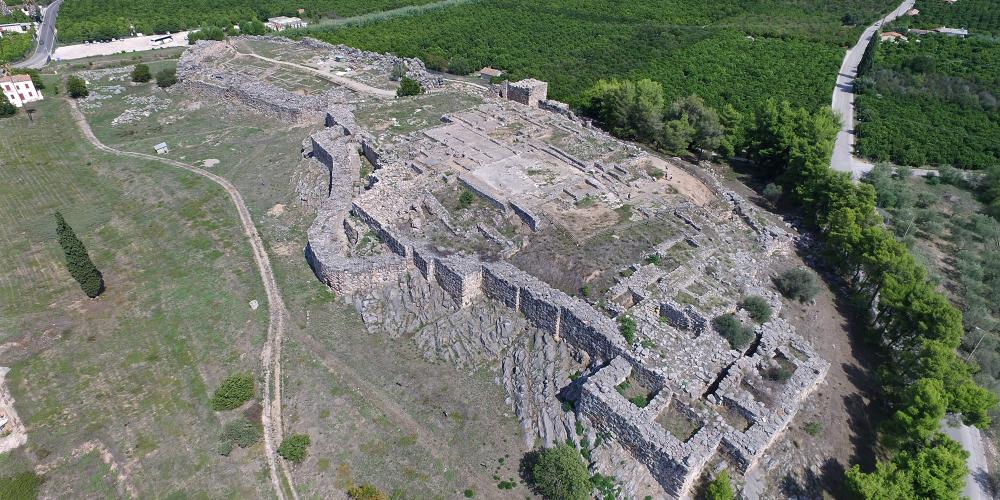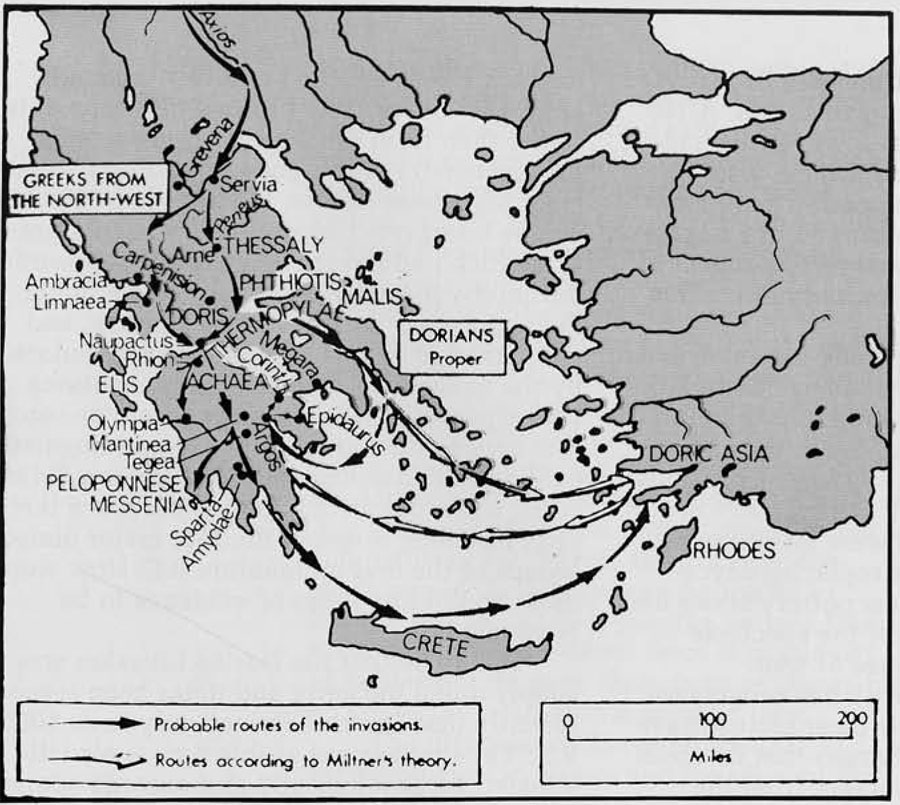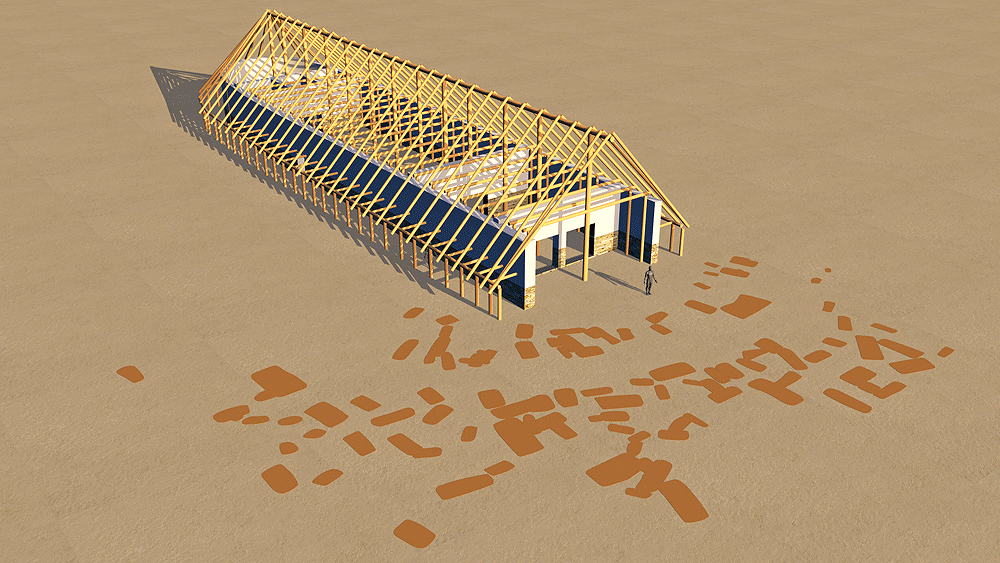
The Problem with the Greek Dark Ages
Jun 13, 2024Following the collapse of the Bronze Age palatial economies, we enter the Early Iron Age, meaning our area of focus shifts to Homeric Archaeology, the Epic tradition and Troy. My intention for this episode is to establish our period & the underpinnings of oral tradition. During the Late Helladic III period, we saw the Mycenaean palaces flourish. The period of the LBA Collapse corresponds roughly to the Late Helladic III B phase of Penepolese, and by the time we reach the Late Helladic III C period all palaces have been abandoned, both on Crete & the mainland. This marks the beginning of the traditionally termed Greek Dark Ages. The interim period around 1100 BCE, right after Helladic III C is still sometimes classified as submycenaean as there appears to be a level of continuity, even though the palaces are gone, the culture still seems to be Bronze Age.
For the successive periods of the Dark Age, we generally use a chronology based on pottery types, a system known as seriation or sequence dating. 100 years later, around 1000 BCE we enter the Protogeometric Age, defined by a style of pottery led by Athens. This early pottery is the first signs of the new emerging cultures, and decoration of these pots is restricted to purely abstract elements and usually includes broad horizontal bands about the neck and belly or concentric circles applied with a compass and multiple brushes. By 900 BCE the Protogeometric matured into the Geometric Age Proper, characterised by a successive series of Early, Middle (where we find the first appearance of human forms) and Late. Here, pottery makes use of geometric motifs in vase paintings that cover the whole ceramic.

By around 700 BCE we enter the Archaic Age of Greece, where Homer begins writing, and archaeologically speaking, things really change drastically after the 8th century. I should say, the terminology “Greek Dark Ages” is often being abandoned in recent scholarship in favour of Early Iron Age, largely due to the pejoritve associations with the term “Dark Age”. Dark Age is also a historical term, not an archaeological one. It is used by historians to denote a period where we have very little -if any, textual sources, but naturally implies a general downward turn in society where knowledge and skills are lost. Naturally, this implies a derogative that somehow the Greeks became stupid and forgot how to do everything they had known in previous periods, but actually, archaeologically that is very far from the case.
It’s true that certain elements are changed considerably, however, which require some explanations. Ian Morris, an archaeologist studying burials during this period around Athens has noted a spike in internments around 800 BCE, but then it falls off, which can give us a clue to the number of people who lived in the area during different periods. One of the questions Morris’ work raises is the nature of burial, i.e who is allowed to have one and who orchestrates it, and how well they truly represent what’s going on. People either disappear from the mainland, or the culture changes so drastically that they are not presenting themselves in the same way anymore, making them very hard to discover archaeologically.

We see this problem played out explicitly in settlements. Early Iron Knossos is a good example of this. Settlements that were used during the Bronze are largely abandoned, or if in use at all, are heavily reduced to small scale hamlets or villages. Urban settlements are always easier to find in the record in comparison to small country houses or highland settlements. Again, there could be the same amount of people, just living in an entirely different way that doesn’t leave archaeological traces as readily. Recent data from the Knossos Urban Landscape project I mentioned a few episodes ago did recover pottery fragments from around the Knossos Valley that are theorised to date to the Early Iron Age, and arguably show a settlement size of around 5000 people, which would necessitate some kind of social hierarchy & structure, but anything deeper is currently unknown.
We do, however, have some settlement evidence, which tells us that things are considerably different. Let’s begin by going back to the LBA III C around 1200-1100 BCE. This sub mycenaean phase has no active palaces. As I mentioned, the culture during this interim time still appears fundamentally Bronze Age. People are staying in older sites during these 100 years, for example in Tiryns, in Argolis that I mentioned in the last episode. During the LBA III C there are still people living in the Lower Town, and they appear to have built a large building in the remains of the ruins of the recently destroyed palace there. While it’s definitely not as sophisticated as the earlier palace, it is a potential signal that people are trying to rebuild.

Moving over to Crete during this period, we see a noticeable movement of settlements into the hills and mountains, away from cities and older palatial compounds. There are competing theories over what exactly causes this influx of new sites to higher ground, but the most common is increasing violence and warfare, perhaps raiding, especially around coastal regions. A good example of these refugee sites is Kastri. It’s right at the top of one of the highest mountains in Crete, and is extremely difficult to get to, so the people living there must have had a very good reason to endure. Again, while invasion hypotheses are common, they often present more challenges than answers.
The Dorians
Following an older generation of scholarship, mainly drawing from Herodotus, it was assumed that the main invaders were the Dorians, one of the four major ethnic groups that later Hellenes divided themselves into. Dorians are referenced in texts as inhabiting Crete and are hypothesised to be a Proto-Greek speaking population who brought the Greek language to the Penepolese. With the discovery of Linear B however, it was shown that ancient Greek was a descendent of the Mycenaean language that had been present in the region since the Early Helladic period, so questions around whether the Dorians really constitute an invasion by a new culture or are actually just a migration have arisen.

Typically, people would argue for an invasion based on changes in styles of pottery, architecture or burials.
The “typical” Dorian house style, found at Nichoria for example begins becoming more popular, and cremations with urns appear to take over internments. While these are certainly interesting, such changes are not uniform and don’t cause a complete abandonment of earlier ages or styles of living, which is not what we would expect from an entirely new culture. Instead, internal or migratory models fit the evidence much better, signalling that the society and culture is changing and adapting to new environments and production styles and finding new ways to be resilient rather than being totally replaced and wiped out by an invading foreign culture who brought all these changes.
One of the major turning points for how we discuss and interpret the early iron age came with the excavation and publication of the site of Lefkandi on the island of Euboea. This site is incredibly important as its occupation is uninterrupted. It can be traced back to the Early Bronze Age, and continued throughout the Bronze and Iron Ages, only ending at the beginning of the Archaic period. In the middle of the site, a huge building was discovered, which throws a wrench in the image that every settlement during this III C phase was poor and isolated. In the 80s the site garnered more attention when a large mound was discovered around the building that contained two very deep shaft graves, one with the remains of a man and a woman.

Both were buried with large horses over the top of the graves. While the male was cremated and had his ashes placed in a bronze urn, the woman was inhumed. Who was buried here? The presence of horses in the graves obviously signals great wealth, and the woman was found wearing high quality, ornate jewellery, including gold and a ring of electrum along with a bronze brazier, and a gorget believed to have come from Babylonia. The man’s ashes being inside a bronze urn also doesn’t come cheap, as the container likely came from Cyprus. The urn was engraved with a hunting scene and placed within a larger bronze offering bowl known as a krater.

Nearly everything we wouldn’t expect during the EIA is here, a hierarchical and social elite expressing themselves differently to surrounding villagers, with clear connections to other powerful people across the Aegean, being buried inside a grave inside an enormous building. Interestingly, the bronze krater in which the man’s urn was placed was already 200 years old by the time it was buried with him. This kind of prestige good isn’t uncommon, even in Homer we find the value of items or objects often being derived from their owners and then passed down through generations as exchanges between powerful people. What is even more interesting however, is that a cemetery with other graves appears to have sprung up around this central grave site.
 This phenomenon, along with the fact that the original mound was found inside a large building, has given rise to the theory that the Shaft Grave at Lefkandi is in fact a very early Heroon, a shrine dedicated to local heroes, popular in later periods and designed to cultivate a hero cult. The burials around the central graves are also comparatively wealthy, including scarabs from Egypt and ivory from the Middle East & Levant.
This phenomenon, along with the fact that the original mound was found inside a large building, has given rise to the theory that the Shaft Grave at Lefkandi is in fact a very early Heroon, a shrine dedicated to local heroes, popular in later periods and designed to cultivate a hero cult. The burials around the central graves are also comparatively wealthy, including scarabs from Egypt and ivory from the Middle East & Levant.
What we’re seeing in Lefkandi is a community that is noticeably wealthier and has eastern mediterranean connections at a time where the rest of the Aegean is really struggling. While Lefkandi is a relatively small settlement, this makes sense in a wider context. Euboean pottery appears all across the eastern mediterranean, and was in fact on the first major export hubs in that regional trade network I mentioned earlier. In other words, Euboea appears to have been very connected with the LBA palatial trade economy, and doesn’t appear to have stopped, even during the LBA Collapse.
The 8th Century BCE
As we move into the 8th century BCE, we really begin to see some drastic changes in Greek culture. Between 800-700 BCE we see an explosion in burials and graves as well as settlements, signalling that a lot of people are returning or manifesting in the archaeological record. We begin seeing temple architecture reappear as well as changes in art and pottery making, especially the emergence of the human form in Greek sculpture. More so than all of this however, we see the emergence of new political identities forming, and the first traces of the later Greek concept of the Polis can be traced to this period. While we see Proto Polisia around Knossos a little earlier, it’s really during this early 8th century at sites such as Gortyn, Athens & Eretria that we find traces of political identities being formed.
The other major change during the 8th century is of course the re-emergence of writing, albeit in a thoroughly transformed way. One of the earliest artefacts that gives us an insight into the development of Greek Writing is the so-called Nestor’s Cup, not to be confused with the Cup of Nestor found in Grave Circle A at Mycenae.
This 8th century wine cup was discovered in 1954 in the San Montano cemetery associated with the ancient trading site of Pithekoussai in Magna Graecia. It contains three lines of inscription in early Chalcidian/Euboeaic Greek that read:
“I am the cup of Nestor good for drinking. Whoever drinks from this cup, desire for beautifully crowned Aphrodite will seize him instantly”
While incomplete and damaged, this statement has been interpreted as some of the earliest evidence for communal wine-drinking among men, in a social ritual that became known as the Symposium in the classical period.
The inscription was added to the cup after its manufacture and is written from right to left, something unique among any known Greek text. The reference to Nestor & his cup is a well known motif from Homer’s Iliad, and has been interpreted as referring to the poem, so a version of the Iliad was likely known by the artist or carver. It’s no coincidence that Homer begins codifying the Epic Tales during this same period. The alphabet used is a derivative of Phonecian and is nothing like Linear B, signalling the interconnectivity of the period and the extent to which Greeks were familiar with foreign scripts and languages.
From this moment forward, the Iliad & Odyssey begin to tell us about people’s concerns and desires during this period, and we move into the Epic Tradition.
Sources
Whitley, A. J. M. 2013: Homer's entangled objects: narrative, agency and personhood in and out of Iron Age texts. Cambridge Archaeological Journal 23(3), pp. 395-416
Faraone, C A. 1996: Taking the 'Nestor's Cup Inscription' Seriously: Erotic Magic and Conditional Curses in the Earliest Inscribed Hexameters. Classical Antiquity. 15 (1): 77–112.
Gaunt, J. 2017: Nestor's Cup and its Reception. In Slater, N, W. (ed.). Voice and Voices in Antiquity.
Morris, I. 1996: Negotiated Peripherality in Iron Age Greece: Accepting and Resisting the East. Journal of World-Systems Research. 2 (12)
Powell, B. 1993: Did Homer Sing at Lefkandi?, Electronic Antiquity 1(2)
Morris, I. 1992: Death-ritual and social structure in classical antiquity. Key themes in ancient history. Cambridge: Cambridge University Press
The Knossos Urban Landscape Project:
Whitelaw, T, et al. 2019: Long-term urban dynamics at Knossos: the Knossos Urban Landscape project, 2005-16. Conference: 12th International Congress of Cretan Studies Volume: 12.
Drews, R. 1993: The End of the Bronze Age: Changes in Warfare and the Catastrophe CA. 1200 B.C. Princeton, New Jersey: Princeton University Press. Five editions between 1993 and 1995
Morris, I. 1991 The early polis as city and state in J. Price and A. Wallace-Hadrill (eds) City and country in the ancient world, 25-57 (available online through online reading list)
Bonnier, Anton & Finné, Martin & Weiberg, Erika. 2019: Examining Land-Use through GIS-Based Kernel Density Estimation: A Re-Evaluation of Legacy Data from the Berbati-Limnes Survey. Journal of Field Archaeology. 44. 70-83.
Lemos, I. 1998: Euboea and its Aegean koine. In B. D’Agostino & M. Bats (Eds.), Euboica (1–). Publications du Centre Jean Bérard
Knodell, Alex. 2021: Transforming Village Societies in the Prehistoric Iron Age. 10.1525/luminos.101.f.
Popham, M, Touloupa, E, SAackett, L, H. 1982: The Hero of Lefkandi. Antiquity, LVI
Don't miss a post!
Sign up to get notified of when I upload as well as any new classes delivered to your inbox.
I hate SPAM. I will never sell your information, for any reason.

